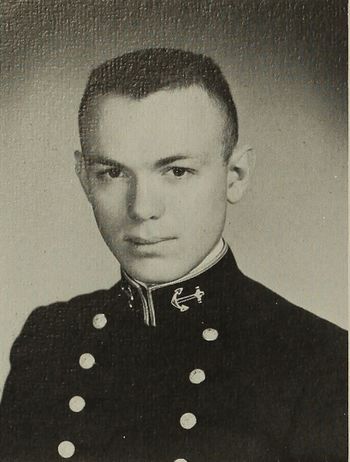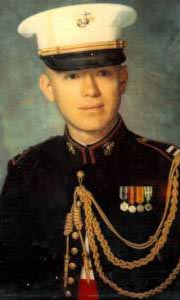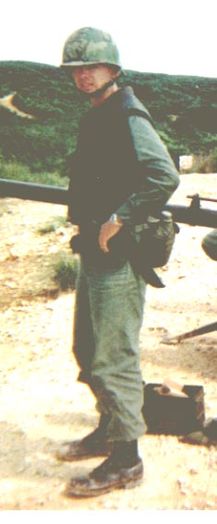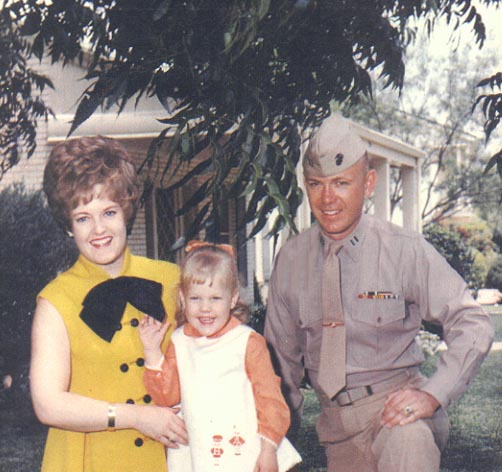WILLIAM A. GRIFFIS, III, CAPT, USMC
William Griffis, III '64
Lucky Bag
From the 1964 Lucky Bag:
WILLIAM ALEXANDER GRIFFIS, III
San Angelo, Texas
Bill
3rd Company
A native of San Angelo, Texas, Bill came to USNA via Sewanne, Tennessee's University of the South, where he was a Kappa Sigma and a liberal arts major. He traded college life, after two years, for military life at USNA and found it much to his liking. Bill was very active in company and battalion sports where his interest lay mainly in track and cross country. Bill's ardent moral and religious outlook should make him an outstanding officer of the U. S. Marine Corps, whose greens he plans to don on graduating. His other plans include marriage and getting off the east coast, after his graduation.

WILLIAM ALEXANDER GRIFFIS, III
San Angelo, Texas
Bill
3rd Company
A native of San Angelo, Texas, Bill came to USNA via Sewanne, Tennessee's University of the South, where he was a Kappa Sigma and a liberal arts major. He traded college life, after two years, for military life at USNA and found it much to his liking. Bill was very active in company and battalion sports where his interest lay mainly in track and cross country. Bill's ardent moral and religious outlook should make him an outstanding officer of the U. S. Marine Corps, whose greens he plans to don on graduating. His other plans include marriage and getting off the east coast, after his graduation.
Loss
From Virtual Wall:
William A. Griffis was graduated from the Naval Academy in 1964, taking his commission as a Second Lieutenant of Marines. He served as a Platoon Leader in Golf 2/6 Marines before being assigned to H&S Company, 2nd Battalion, 5th Marines, 1st Marine Division, in Vietnam, where he commanded the Quick Reactionary Force.
His began his second tour of duty with the Naval Advisory Group, USNAVFORV, in June 1969, and died when the helicopter he was aboard - UH-1H tail number 67-17559 of A Troop, 7th Squadron, 1st Cavalry - went down. The USNAVFORV History for Jan 1970 contains the following entry:
Following a four day stand-down posture, Brigade "B" [RVN Marine Corps] began RIF operations in the 7th ARVN Division AO of Dinh Tuong Province ten miles to the north and northwest of Vinh Long (4th Bn WS991496, 5th Bn XS016520, 6th Bn XS061474, and 2nd Arty Bn WS983413). Confronting a situation similar to the operations earlier in the month, the Marines faced an evasive enemy who continued to place his major emphasis on mines and booby traps. In one booby trap incident that took place on 24 January, Capt William A. Griffis III, two RVMC, including the executive officer of the 4th Infantry Battalion, and one USA [US Army] were killed when a booby trapped enemy ammunition container exploded within a helicopter. Three USA soldiers were also wounded, and the helo was completely destroyed.
The US Army loss was the door gunner, SP4 Nathaniel Thomas of A/7/1 Cavalry.
Obituary
From Find A Grave:
Bill, "Griff" was born in Lubbock, Texas, the oldest of three children born to Mr. and Mrs. William A. Griffis, II. His father was an attorney and the family moved to San Angelo where his dad started a law practice. Bill spent his early years in San Angelo and was a 1958 graduate of San Angelo Central High School. While in high school, he ran track, was a member of the "Zocolos", a social fraternity affiliated with the YMCA and was active in the Episcopal Youth Group.
Bill was an outstanding student. After high school, he attended Suwannee University for two years. He successfully sat for the entrance exam for the United States Naval Academy and entered as a midshipman in the fall of 1960. He graduated in 1964 and entered the United States Marine Corps.
Bill and his future wife Sally Baggett had known each other casually through mutual friends and it was not a love at first site thing. Sally stated that it was a case of a big city attorney's son and the daughter of a small town rancher from Ozona, Texas. "We did not like each other, he wouldn't even dance with me at a Paul Jones dance when the whistle blew." In the summer of 1962, they became reacquainted when they met at a gas station in San Angelo. In his junior year at the Academy, she accompanied him to the Army/Navy game and then to the week of graduation for the ring dance. It was there where he proposed. Bill and Sally were married as soon as Bill graduated from the Naval Academy in the summer of 1964.
As soon as Bill was commissioned as a 2nd Lieutenant, his first stop was Quantico, Virginia for his basic course and initial training, he, then was assigned as a platoon leader with the 2nd Battalion, 5th Marine Regiment, First Marine Division at Camp Lejuene, North Carolina from 1965-66. He then departed for his first tour in Vietnam with the 2/5, 1966-67. While in Vietnam he was assigned to Headquarter and Service Company, 2nd Battalion, 5th Marines where he commanded the Quick Reactionary Force. While in Vietnam, his first daughter, Sara was born in March 1966.
Lt. Griffis returned from Vietnam in 1967 and then was assigned to Camp Pendleton, California where he served as Aide de Camp for Major General Lewis J. Fields. In 1968, Capt. Griffis then reported for duty at Quantico, Virginia to attend AWS and Advisory School. He departed for his second tour as a member of the Naval Advisory Group, Military Assistance Command-Vietnam (MACV), June 7, 1969. He was assigned to the Delta region advising RVN marines. On January 24, 1970, Capt. Griffis was a passenger on helicopter UH-1H tail number 67-17559 of A Troop, 7th Squadron, 1st Cavalry Division. The aircraft picked up an ARVN Major and several ARVN soldiers near a rice paddy. The ARVN's had captured an ammunition box during their operation and they brought it on board. As the aircraft was being lifted off, one of the ARVN soldiers sitting between Capt. Griffis and an ARVN major started to open the box. Capt. Griffis attempted to intercede, the box was booby trapped and it exploded. The explosion torn up the transmission box of the helicopter and thus interfered with the hydraulics making them inoperable. The aircraft came down and landed upside down in the paddy. The pilot, the co-pilot and the gunners made it out safely. Capt. Griffis died within minutes most likely due to the explosion versus the crash. Capt. Griffis was the only U.S. casualty on board.
His second daughter, Mitty was born on January 23, 1970, but because of the time difference, his death was about 18 hours after her birth. He never knew that he was the father of a second daughter.
Capt. Griffis was buried in San Angelo, Texas at the Fairmont Cemetery with full military honors. He is survived by his wife, Sally, his daughters, Sarah Griffis Gee and Patricia "Mitty" Griffis Mirrer, his brother Don, an attorney of San Angelo and his sister Sallie Griffis Helms of Houston.
Sally Griffis has traveled and written much about her husband, Bill. She now lives in Peachtree, Georgia. She earned her B.A. degree in education and her M.S. in counseling psychology and has done many hours toward her doctorate in psychology. Her research project was "The Copeing Patterns of Widows of War." Sarah Dees is married to a physician with a specialty of Emergency Medicine and they live in Virginia. She earned her B.A. degree in Education and her M.Ed. in counseling. Patricia "Mitty" Mirrer is married to an orthopedic surgeon and they live in Rhode Island. She earned her B.A. in broadcast journalism. She has won many awards including the Edward R. Murrow for Journalism Excellence (regional) and has been nominated for an Emmy.
Bill and Sally are the proud grandparents of Hannah Grace Dees, age 4; Abigail Dees, age 2; Alexandria Sally Mirrer, age 3; Emma Elizabeth Mirrer, 4 months and Sarah is expecting a third child in December 2004.
In 1997, Sarah and Mitty accompanied Sally on a one of two research project trips to Vietnam. Mitty was employed by ABC 26 of New Orleans at the time and a photographer accompanied them to document the journey. The 4-part series was shown nationally on ABC and affiliated stations in 1997 and several times since.
Photographs
Remembrances
From Wall of Faces:
Mr. Griffis: We met when you became my Platoon Leader in G/2/6 in 1965. You were first to congratulate me when I was admitted to NAPS later that year. Your leadership was outstanding and your guidance is helped fashion the Navy Cross I received in 1968. Thank you, Sir. Rest well, Skipper. THOMAS PANIAN, 4/12/01
From Wall of Faces:
I served with "1st Lt. Bill Griffis" as one of his squad leaders in 2/5 Quick Reactionary force in 1966-67. No other officer was more of a asset to his country and corps than my commander. He was a fine man, and a excellent officer. The marine corps needed more men like him. The highest tribute I can pay to Capt William A. Griffis in death is to never forget him, for which I shall not do.
Cpl L.J. Williams, Squad Leader, 2058938
Quick Reactionary Force, H&S (106's)
2/5 1st Mar Div, FMF, I Corp, Quang Tri Province L. J. (WILMA) WILLIAMS, UA@MVCC.COM, 1/19/00
Other
John's wife has a long piece on the events surrounding her first visit, with her daughters, to the Vietnam Veterans Memorial Wall in Washington, DC.
In addition to his wife, John's younger daughter became an advocate for Gold Star Children and made an award-winning documentary series on the subject. From Marine Base Quantico on November 7, 2013, by Chuck Jenks:
Mitty Mirrer became a gold star child at birth.
Half a world away, Mitty’s father, Marine Capt. Bill Griffis III, was killed when a bomb exploded in his helicopter while on a mission as an advisor in Vietnam.
Just after Mitty was born and still in the maternity ward, a chaplain and another Marine Corps officer darkened the hatch at the hospital and told Sally B. Griffis that her husband was dead.
Mitty and her then four-year-old sister Sarah had lost their father to war.
They were now Gold Star Children. During the Vietnam War, an estimated 20,000 American children also lost a parent to the war.
In the 1970s, military widows were given 30 days to move off the base. Because of this Sally raised her two young girls in her father’s hometown, San Angelo, Texas.
Mitty’s mother surrounded herself with family. There were no support groups for families, certainly no internet to reach out. There were no books on the shelf of “How to be a military widow”… there was nothing, but silence.
“That silence is a common thread for my generation of Gold Star Children from the Vietnam War. This is likely true for the many, many children left behind during World War II and the Korean War, as well,” Mirrer said.
“The difference with the silence for the Vietnam War, was many of the mothers thought they were protecting their children by not talking about the ‘unpopular’ war. It was a travesty that children and families were essentially ignored during that time. Like our Vietnam veterans of today, our Gold Star Children from the Vietnam War are part of a growing group of people working to ensure today’s Gold Star Children are empowered by community and recognized for the sacrifice their families have made for this country.”
As children, Mitty’s sister and she grieved in silence.
But more importantly, “we had no idea we had the right to grieve our father, somehow we understood that kind of emotion and acknowledgement was too much. Our family simply didn’t have the emotional resources to deal with the Vietnam War death of my dad,” she said.
Mitty began to observe the effects of the loss of her father as she grew older. Questions came to her mind.
As she grew up, she attended the University of Mississippi and graduated from the School of Journalism, then began working as a broadcast news reporter for affiliates in Philadelphia, New Orleans and Jackson, Miss.
In 1992, Mitty made her first visit to the Vietnam Memorial Wall in Washington, D.C. “I went to the Vietnam Veterans Memorial as a reporter and saw my father’s name on the Wall for the first time. This was very difficult, but it gave me context for being there. I needed that. It felt so emotional,” she said.
In 1997, when she was working for the ABC affiliate in New Orleans, Mitty’s mom was researching widows of war and found little information. The only information she could find was based on war widows of Israel. She decided to interview widows from the Vietnam War.
“I went to my news director and pitched her the story of our family going to Vietnam, to the place my father died; a man of whom I knew very little. Mitty was 27 years old.
“I brought a videographer with me and produced a documentary series on our family’s journey. The series broadcast to Tribune stations around the country and won several awards. I began to feel like my father’s daughter. I knew a little more about who he was, where he served and I walked hand-in-hand with my mother and sister across the field where he had died,” Mitty said.
Mitty earned a Regional Edward R. Murrow Award for her documentary series on her own family’s journey to Vietnam.
“Simply recognizing the loss is tremendous for a child, for anyone,” Mitty said.
But this would not be her last documentary.
After 9/11, Mitty began to wonder about the children who would be left behind by today’s wars.
Bonnie Carroll, who is a military widow and founder of Tragedy Assistance Program for Survivors (TAPS) helped create community through her growing non-profit organization for these families. Children, parents, extended family all had a place to talk about their shared military loss.
“I mentored a child who had lost her father in Iraq and was overcome by how articulate these children could be about the deaths of their active duty parent. There were several Vietnam era Gold Star Children who were reaching out as well, it was their intent to make sure this generation of Gold Star Children would not be forgotten,” Mitty said. “With the support of so many people, I went back to several military survivor conferences and began to interview widows, widowers and Gold Star Children from two generations of war.”
According to Ami Neiberger-Miller, a case manager at TAPS, there are 4,742 Gold Star Children from Operations Enduring Freedom (Afghanistan) and Iraqi Freedom (Iraq). But, Miller states that figure is low because it only counts those children whose parents died in theater. The number does not include those parents who died as a result of accidents or suicide. The death of a parent impacts the life of a child forever.
Eight years ago, Mitty began another film journey. To tell the story of today’s Gold Star Children.
Mitty has produced a new, hour-long documentary film, “Gold Star Children: Two Generations Sharing Loss and Healing,” and takes an intimate look at American children who’ve lost a parent to war across two generations.
The documentary is told through the eyes of a nine-year-old-girl whose father was killed in Iraq.
Gold Star Children is a 501c3 not-for-profit to help raise awareness about our children of the fallen. The film is available starting Veteran’s Day for digital download at www.goldstarchildren.org.
At noon on Veteran’s Day, there will be a free showing at the Women in Military Service for America (WIMSA) Theater at Arlington National Cemetery.
The Pentagon Channel will also broadcast “Gold Star Children” at 8 p.m. Monday, Nov. 11. On Nov. 14, the film will be shown at the U.S. Naval Academy during a private showing. The film follows the parallel journeys of two generations of grieving children – recent war orphans who’ve lost parents serving in Iraq, Afghanistan, Bosnia and here at home, with the now adult children who lost parents serving in Vietnam.
“Gold Star Children” weaves stories together showing the similarities and the differences between children of these two generations, and more importantly, shows they can help each other heal when they come together.
For each child in the film, there are hundreds whose stories remain untold, but reflect the same tragedy and heartache. Yet, like the children in the film, they are resilient and strong, growing up to epitomize the very best of America’s spirit of public service and coming together after tragedy. These families understand the heart of America in a way that few others do.
They are the faces of war on the home front and their inspiring stories of growth and love after going through trauma and living with loss, now has voice.
Capt. William A. Griffis III was a 1964 graduate of the U.S. Naval Academy. He was on his second tour of duty when he was killed … just hours before Mitty was born. He never knew he had a second daughter.
“My whole goal is to have people today ask themselves ‘what is it that I can do to help’ Gold Star Children,” Mitty said.

The "category" links below lead to lists of related Honorees; use them to explore further the service and sacrifice of alumni in Memorial Hall.


